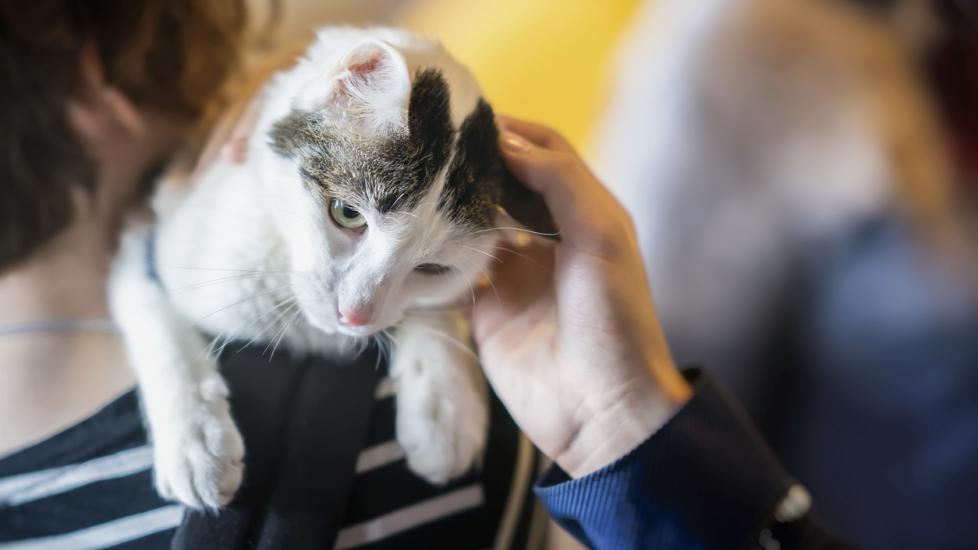What To Know: Adopting a Deaf Cat
Adopting a Deaf Cat
Hearing plays a vital role in how a cat interacts with its surroundings, and bonds with humans. Deafness, or the loss of hearing, can affect that bond, but only if allowed. Many deaf cats adapt easily and go on to live relatively healthy and happy lives. If you are looking for that next furry forever friend, consider adopting a deaf cat. It will only require a few small adjustments on your part.
Deafness in cats has been classified into three main types:
-
Hereditary/Congenital deafness: A genetic defect usually seen in cats with blue eyes and white fur, and usually noticed within the first few weeks of life.
-
Sensorineural deafness: Occurs due to a loss of nerve cells and is irreversible. It may result from:
-
Trauma
-
Loud noises
-
Certain toxins and drugs (like aminoglycosides, a type of antibiotic)
-
Inner ear infections
-
Meningitis
-
Anesthesia
-
Cancer
-
Aging (presbycusis)
-
In addition to hearing loss, your cat may also experience a head tilt, fever, or circling.
- Conductive deafness: This type of deafness is usually attributed to an underlying cause, such as a middle or outer ear infection that blocks sound from reaching the brain. This condition can usually be restored if the obstruction is resolved.
Any of the above can affect one ear (unilateral) or both ears (bilateral) and can result in either a complete or partial hearing loss where only certain sounds or frequencies are affected (usually the higher frequencies are affected first).
Recommended Products
How to Prepare for a Deaf Cat
When working with shelter’s staff to prepare yourself to bring a deaf cat home, ask the following questions:
-
What are the circumstances (if known) that led the cat to be placed in a shelter?
-
How long has the cat been deaf?
-
What was the cause of the deafness, if known?
-
If the deafness was a result of a toxicity (i.e., from prior medications), which one(s)?
-
Was the cat trained with nonverbal commands? If so, what were they?
-
What special diet is the cat currently on? How much food is provided, and at what times? What other options can be considered if a special diet is not available?
-
Are there in-house or low-cost testing options, coupons, or discounted medical care available to help with future costs?
Schedule a Veterinarian Appointment for Your Deaf Cat
After adoption, be sure to schedule an appointment with your family veterinarian to have a full exam completed, and share the answers to the above questions, as well as your cat’s medical records. Your vet will perform an otoscopic ear exam to determine if the eardrum is present and/or shows signs of disease, such as debris, redness, and inflammation. If your cat suffered from chronic ear infections in the past—of which deafness was the result—be sure to ask about the frequency of recheck exams and how best to manage future ear infections at home.
If you are curious as to the type of deafness, or want further clarification as to whether it is partial or complete, ask your vet about the brainstem auditory evoked response (BAER) test. Behavioral testing may be difficult, as a cat can adapt rather quickly, but it may be possible to notice if the cat’s ears or head moves toward a sound when made. A BAER test is noninvasive and often performed by a specialist. Responses to sound are recorded and measured by the placement of electrodes to determine hearing loss.
Managing Your Deaf Cat at Home
Once your cat is acclimated to a new home and environment, you will likely not need to make any additional trips to the veterinarian outside of regular checkups. It is recommended that your new cat be examined by your family veterinarian soon after adoption so that your cat can become an established patient and have any records and prior medical history evaluated.
Keep in mind that while there may be no additional medical care needed, altering your initial perceptions about living with a deaf cat may be required. Your cat may be a little more difficult to rouse from a sleep, make louder-than-normal vocalizations (such as meowing), have variations in its feeding schedule (therefore a routine is best), and startles easily. Try to get the cat’s attention first prior to attempting to pet or pick it up. This will avoid avoiding starting it and prevent inadvertent scratching and biting.
How to Communicate with a Deaf Cat
Hearing is an important sense. Not only do cats utilize it for safety, communication, hunting behavior, and consumption of food, but they also use it for “talking” and listening to their pet parent. It is one of the most important aspects of the human-animal bond.
When that communication is broken, so, too, can the bond. But as you may well know, there is more than one way to communicate with our feline friends.
What a cat lacks in hearing ability can generally be compensated with other senses such as movement and vision, so try using hand signals and body language for training purposes. Alternatively, flashlights or similar objects can also be used, as well as vibrations made by stomping on the floor or knocking on surfaces.
And don’t forget the sense of touch. Deaf cats are just as responsive to petting and rubbing as are those with normal hearing.
Long-Term Management of a Deaf Cat
Managing a deaf cat in your home may require a little more patience and, at times, a nontraditional training approach. Deafness, however, should not define your cat or your pet-human relationship. A few simple rules to live by will certainly enable you both to get the most out of your time together:
-
Keep the environment and your cat safe. Deaf cats are at increased risk of injury from things like motor vehicles and predators. Consider screened-in enclosures or keeping your cat indoors, or even train your cat to walk on a leash and harness.
-
Consistent routine not only helps with anxiety, but it also promotes a greater sense of well-being and quality of life. Provide scratching posts, plenty of litter boxes, toys, window perches, etc.
-
Utilize visual cues for communication.
-
Even though your cat may not hear it, keeping a collar and bell, or some sort of pet tracker or finder, can help you and your loved ones keep track of your cat. It also is a great way to alert you if the cat is in danger or if it has caused any trouble.
What is the cost for having a deaf cat?
While there may be more of an initial investment when adopting a deaf cat, the deafness (unless due to chronic ear infections) shouldn’t be a significant cost concern going forward.
Featured Image: iStock.com/Svetlanais




